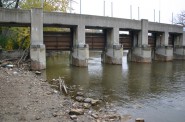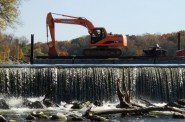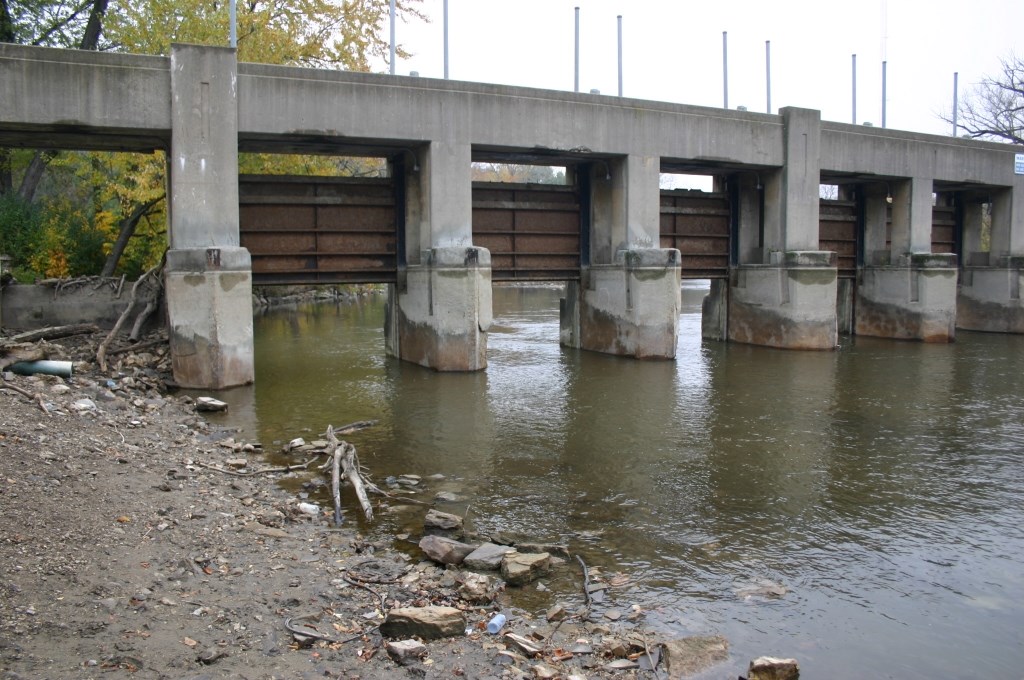Estabrook Dam’s Environmental Impact
Green activists support the dam’s removal, but that might actually hurt the environment.
Dams can certainly have negative environmental impacts.
They can serve as barriers to the migration of certain kinds of fish (those that undertake regular migrations in large freshwater systems). They can function as traps for the accumulation of sediment and pollutants. They can negatively impact water quality by raising temperatures and lowering dissolved oxygen levels.
Moreover, they have often outlived their purpose. In Wisconsin, many dams still in use were built in the 1800s to provide a reliable and controlled source of water to power various types of mills or early industrial facilities. In terms of their original purpose, these dams are now obsolete. Such was the case with the North Avenue Dam, which was removed from the Milwaukee River in 1994 and resulted in widely reported improvements in the ecological health of the former impoundment, as best demonstrated by an increase in the number of fish species from eight to more than forty.
When it comes to the Estabrook Dam, an assumption shared by all parties is that its repair — should that option be chosen — would occur in conjunction with construction of a fish passage, addressing one of the key environmental concerns associated with the dam. But even with construction of a fish passage, the dam could in theory cause an array of other negative environmental impacts, including: (a) buildup of sediment behind the dam and within the impoundment; (b) potential impacts of the seasonal drawdown on mussels and other aquatic life in the impoundment (through desiccation, predation, and freezing of the mussels); and (c) general degradation of water quality and wildlife habitat within the impoundment. The environmental assessment (EA) prepared for the dam expands on this last point: “Specifically, the replacement of a naturally flowing stream channel with an essentially stagnant pool of water eliminates extensive wetlands and floodplains by covering them with water. It also results in higher water temperatures and lower dissolved oxygen levels. Other impacts include sedimentation, degraded sediment, and impacts to stream channel structure. These conditions have been identified as a major cause for the decline in fish community diversity, abundance, and structure in Wisconsin. These cumulative impacts can directly and indirectly impact the overall viability of individual fish species, reproduction, food supply and growth, predation, resistance to disease and stress, etc.”
The Estabrook Dam would seem to be an ideal situation for demonstrating the benefits of dam removal, as the free-flowing conditions that would result have already existed for more than seven years as a result of the WDNR order to open the gates in 2008. Unfortunately, almost no water quality or ecological data appears to have been collected from the impoundment area during this time that would document increases in oxygen levels, fish and mussel populations and diversity, or decreases in peak summer water temperatures. As a consequence, most of the environmental arguments in support of removal are based on general assumptions rather than analysis or data specific to the Estabrook Dam. And these assumptions are worth examining in detail.
Sediment Accumulation Concerns
One of the most significant environmental concerns if the dam is repaired is the potential for long-term accumulation of sediment within the impoundment as well as the seasonal release of sediment that would occur when the gates are opened each fall. The amount of sediment transported by a river is dependent in part on the flow velocity of the water. When a river enters an impoundment formed by a dam, the velocity of the water decreases, resulting in an increase in the amount of sediment settling from the water. Evidence of this process is visible within the former impoundment area of the North Avenue Dam, where several hundred thousand cubic yards of sediment were left in place following dam removal. Typically, the water level in a dam’s impoundment is lowered each fall to reduce the risk associated with accumulation of ice behind the dam during winter months. Even if the gates for the dam are gradually opened, the flow of water within the impoundment area would increase for a period of several days, potentially resulting in erosion of some of the accumulated sediment and transport of this sediment downstream where it could harm habitat areas.
It should be noted that the accumulation of sediment along a river is not always a concern, as the transport of sediment is a dynamic process occurring at nearly all times in every river, with erosion typically occurring in areas of the river where current is flowing the fastest, and the accumulation of sediment occurring where flow is relatively slower. The key issue for Estabrook Dam is whether the repair of the dam, and the continued existence of impoundment, would result in significant net accumulation of sediment over time. This question does not appear to have been addressed in any of the evaluations performed to date.
Reviewing some of the scientific literature on dams, it turns out it is possible to estimate the “efficiency” of an individual dam impoundment in trapping sediment based on the ratio of the normal reservoir capacity to the mean annual flow volume. According to Dam Removal Research: Study and Prospects, “Reservoirs with a capacity to store more than 10 percent of the average annual inflow would be expected to trap between 75 and 100 percent of the inflowing sediment. Reservoirs with a capacity to store 1 percent of the average annual inflow would be expected to trap between 30 and 55 percent of the inflowing sediment. When the reservoir storage capacity is less than 0.1 percent of the average annual inflow, the sediment trap efficiency would be nearly zero.” The greater the relative size of the reservoir, the greater its sediment trap efficiency and the amount of reservoir sedimentation that will occur. For example, the Hoover Dam forms an impoundment (Lake Mead) that is up to 590 feet deep and which took nearly six years to fill following completion of the dam. Water within Lake Mead therefore has an approximate six-year residence time, resulting in conditions in which essentially 100 percent of sediment is captured by the reservoir.
So the dam may present no problem of sediment accumulation. And historical records as well as recent observations suggest that may be the case. A deep swimmable pool reportedly existed in this section of the Milwaukee River prior to construction of the dam, even though the river had been impounded for hundreds if not thousands of years by the natural dam formed by the rock ledge that was removed in the 1930s as part of the channel deepening project performed in conjunction with dam construction. The lower portion of the impoundment was largely clear of sediment when surveyed in 2010 as part of planning for the second phase of contaminated sediment removal project, with only 6-inches of sediment present above the bedrock beneath the I-43 bridge. In the portion of the river lying south of Hampton Avenue, the main channel “contained a very thin to nonexistent sand layer of sediment above a bedrock subsurface.” All this suggests the flow dynamics within both the natural and man-made impoundment are sufficient to keep significant portions of the impoundment largely free of sediment.
In fact, its possible that removal of the dam might actually exacerbate accumulation of sediment within the former impoundment area. Nearly 30 acres of the former impoundment will eventually become covered by trees and other vegetation if the dam is permanently removed. This process may already be occurring as a consequence of the drawdown in place since October 2008. Significant accretion of sediment in vegetated areas could potentially occur over the next one or two decades before an equilibrium condition is established between the growing (and eventually mature vegetation), flood flows, and the channel geometry. The Southeastern Wisconsin Regional Planning Commission reportedly adjusted their model for changes in “roughness” associated with the newly vegetated areas but not for changes in channel geometry that could occur as a result of sediment accretion.
In conclusion, there may be no benefit in removing the dam in terms of sedimentation issues, and there is at least the possibility that removal of the dam could exacerbate sedimentation over the next decade as the channel in this area responds to the continued maturation of vegetation on approximately 30 acres of former impoundment.
The Occurrence of Stagnant Conditions within the Impoundment
A general environmental concern if the dam is repaired is that water within the impoundment will be stagnant. To better understand the behavior of water within the Estabrook Dam impoundment, and the relative degree of stagnation, I calculated the residence time for water in the impoundment for different flow rates that have occurred historically, as well as projected flows when flooding occurs.
| Estimated Residence Time for Water in the Estabrook Dam Impoundment for Different Flow Rates | |||||
| Flow Rates | Approximate Residence Time | Comments on Flow Rates | |||
| Cubic Feet per Second | Cubic Feet per Hour | Cubic Feet per Day | Days | Hrs. | |
| 117 | 421,200 | 10,108,800 | 3.0 | 72.5 | Mean minimum summer flow (2008-14)* |
| 240 | 864,000 | 20,736,000 | 1.5 | 35.4 | Median flow (1915-2014)** |
| 451 | 1,623,600 | 38,966,400 | 0.78 | 18.8 | Mean flow (1915-2014)** |
| 500 | 1,800,000 | 43,200,000 | 0.71 | 17.0 | |
| 619 | 2,228,400 | 53,481,600 | 0.57 | 13.7 | Mean summer flow (2008-14)* |
| 1,000 | 3,600,000 | 86,400,000 | 0.35 | 8.5 | |
| 2,000 | 7,200,000 | 172,800,000 | 0.18 | 4.2 | |
| 4,730 | 17,028,000 | 408,672,000 | 0.075 | 1.8 | Flow rate for 2-year flood |
| 8,790 | 31,644,000 | 759,456,000 | 0.040 | 1.0 | Flow rate for 10-year flood |
| 14,800 | 53,280,000 | 1,278,720,000 | 0.024 | 0.6 | Flow rate for 100-year flood |
| 18,200 | 65,520,000 | 1,572,480,000 | 0.019 | 0.5 | Peak recorded flow (7/22/2010) |
| * Calculated by author using reported flow data for the Estabrook Park flood gage (U.S.G.S. Gage 04087000for the period May 15 to September 15 of each year.** Data as reported in the Draft Environmental Assessment Report dated August 2014 prepared by AECOM. Residence times are calculated using the reported volume for the impoundment (with gates closed) of 700 acre-feet (=30,555,000 cubic feet). | |||||
The table is less accurate for higher flows occurring during major flood events when the volume and reach of the river would be significantly increased. Still, the numbers are useful for illustrating that at the long-term mean flow rate of 451 cubic feet per second (cfs), water in the impoundment would have a residence time of less than one day. During summer months when the gates would be closed, based on the mean summer flow from May 15 to September 15, the flow of water in the impoundment would still be great enough to result in the replacement of the full volume of water approximately two times each day. Approximately 290 million gallons of water per day move through the impoundment at the mean flow rate of 451 cfs, and over 400 million gallons per day at the flow rate of 619 cfs. Therefore, even with the dam in place, water continues to flow through this section of the Milwaukee River at a slow but significant rate.
The flow data are also relevant to concerns associated with seasonal lowering of the water level in the impoundment. A 10 percent increase in the mean flow rate of 619 cfs would be sufficient to reduce the volume of water in the impoundment by 50 percent over a six-day period. The magnitude of the increase in flow necessary to partially drain the impoundment is dwarfed by the magnitude of flow changes that occur each year associated with even minor flood events (for example a 2-year flood event with a flow of 4,730 cfs) and which would continue to occur even if the dam is removed.
Article Continues - Pages: 1 2
A Freshwater Controversy
-
The Path Forward for Estabrook Dam
 Feb 10th, 2016 by David Holmes
Feb 10th, 2016 by David Holmes
-
Does the Estabrook Dam Cause Flooding?
 Dec 30th, 2015 by David Holmes
Dec 30th, 2015 by David Holmes
-
Repairing Estabrook Dam Will Cost Less
 Dec 23rd, 2015 by David Holmes
Dec 23rd, 2015 by David Holmes






















Oh by the way, the dam is really ugly too.
I can’t understand the entire controversy given that the dam doors are open at all times so what is the difference if the structure stands or not? The dam also serves as a bridge to the cool island to the West and even thought it is nominally locked many fisherman and others climb over to get to the bridge. It certainly isn’t ugly and with a little enhancement it would be very attractive in its deco style. What is ugly is whatever the DNR or whoever did to the West bank last summer, cutting down hundreds of old stand trees and dredging and then reseeding and planting stick trees. That was shocking!
I’m curious about this series of articles, is this really journalism meant to inform or persuade? At first glance, this seems like a serious look at the issue but the series always concludes that money needs to be spent maintaining or rebuilding the dam.
Gems like this one:
“Temperature extremes could also be exacerbated during summer months if the dam is removed, due to the very shallow water depths that may develop.”
The water would be faster flowing and wouldn’t have nearly the same size area to gain heat from the sun… under what process would that increase the water temperature?
Tim,
From the onset the author said these articles were intended to persuade his view that removing the dam is not a good idea. To answer your mechanism question, in summer the river is very low and slow. Without the dam (see below) water levels upstream will be very much lower. Shallow water allows sunlight to reach the river bed and heat up the ground. This makes the water hotter. In other words a shallow pool is hotter than a deep one given the same surface area.
I’ve asked before and I’ll ask again. I wish the author would expound on the fish passage idea. The Thiensville photo is very interesting. I also still think people are confused about what “the dam” actually is. I know I was. The gates by themselves are not the dam. The dam is the entire built up wall running across the river. In fact you could remove the gate structure completely and the river would still be considered dammed – no “n” 😉
After reading this series of articles I no longer am in favor of removing the dam. In fact I now know I never was. All I want is to remove the ugly gate system and replace it with a falls that fish can pass. I’d love to see the winding, stepped dam be cleaned and restored for sitting and picnicking.
D’nardo
I didn’t realize that the gates were superfluous. Thanks D’nardo for this info. I think the dam can be modified for the fish passage and be re-formed to be a pleasant destination for all.
“In other words a shallow pool is hotter than a deep one given the same surface area.”
That’s my point, the total amount of flow is unchanged. The surface area is the variable, more surface area vs less. The large pooled area might be slightly deeper but itself is the collector of the sun’s heat that warms the water.
Less pooled area = less solar temp gain. If you don’t believe me, that’s fine, but I’m not the one talking about an alternate law of physics.
Tim,
You must have missed that day in physics class. You’re saying that a pool with 1 square mile of surface area will be the same temperature whether it’s 6″ deep or 6 miles deep. That’s incorrect.
The Milwaukee River is shallow. In late summer it’s really shallow – you can walk across it south of Capital. The Estabrook dam (either the ancient natural or the modern man-made) keeps the upstream pool area deep and less susceptible to summer warming. If we remove the dam (not just the gates), the upstream water will become shallower and hotter.
About flow: A dam (let’s say a natural dam) limits flow when the river levels are low. So in October a dam will prevent water from flowing but maintain the upstream pool. But that same dam has almost no effect during spring floods because all the water levels higher than the dam flow freely over it. You can’t talk about flow as a simple number. It doesn’t work that way.
I’m not a civil engineer, but I did pass my physics classes.
D’nardo
So if there is going to be no change in environmental conditions, why pay to rebuild it? Get rid of it. The thing people fail to recognize is that rebuilding it puts everyone on the hook for maintenance and risk for the foreseeable future. Additionally, the author claims that only 10 homes will be removed from the floodplain if the dam is demolished. Why are these 10 homeowners less important than the homeowners that surround the impoundment? Let’s be smart about our infrastructure. Just because it was built once doesn’t mean it MUST be replaced. Can we please match our resources to our footprint?
I regret that I disagree with the author that the removal of the North Ave Dam. was environmentally beneficial. Further, I suggest analysis of actual sediment transport which occurred will demonstrate that the North Ave. Dam removal effected the greatest ECOLOGICAL and ECONOMIC catastrophe in the history of SE Wisconsin since the 1875 typhoid epidemic. The method used by the WDNR to calculate the transport of highly contaminated and definitely cancer correlated river bottom soils produced an estimate of 3156 tons (ref Mar 21, 1991 WDNR letter to Milwaukee Mayor John Norquist) . The corrected theoretical calculations sent to the WDNR recently show over 419,000 tons were actually dumped into our estuary and our drinking water supplies in Lake Michigan . The hypothesis that this transport almost certainly caused the March 31,1993 cryptosporidium epidemic and the subsequent cladophera / e-coli algae blooms which virtually eliminated use of our Lake Michigan swimming beaches can now be evaluated by simply duplicating the Sediment Transport Section of the Woodward Clyde Study of 1994. If the 419,000 ton figure is correct, the taxpayers serviced by the Milwaukee Water Dept. have paid over $340 Million to redo the Texas Ave water intake and the Howard Ave Water Treatment Plant , plus an estimated $50 Million in legal costs for the crypto lawsuits, plus the collateral damages of loss of use of our beaches , plus the seasonal stench on near shore areas due to rotting algae , not to include the human misery caused to 400,000 people who lost wages, health and in over 54 cases, their lives. Such allegations I believe are significant enough to justify an investigation of the facts and a re evaluation by all of us regarding a history of insufficient foresight by dam removal advocates in this state.
D,
For the comparison of this summer day, between having an impoundment and not, there is no difference in the total flow in the river.
This is what turns the impoundment, even if it’s deeper, into a solar collector that warms the water. Since the area of the river gets wider, please remember that the flow volume of the river is unchanged, and thus causes the speed of the water to decrease.
So, you have the water covering more area becoming a larger solar collector and it’s in that state for a longer time, since the speed of that section of the river is slower.
I understand it’s counterintuitive that a shallow, running stream/river would be cooler than a relatively deeper impoundment but the depth is counteracted by the other factors.
Once again, skepticism is a good thing, but it might help to skim this.
https://www.google.com/url?sa=t&source=web&rct=j&url=http://www.michigandnr.com/PUBLICATIONS/PDFS/ifr/ifrlibra/research/reports/2058rr.pdf&ved=0ahUKEwiCw8e4-LXKAhULvYMKHVLRAI4QFgggMAI&usg=AFQjCNEQtVdzTDTnpayL84pGF2jSyGvclQ&sig2=5p-43Uj5osJHXHlclIUttQ
For a comprehensive counter argument to Mr. Holmes please follow this link.
https://static1.squarespace.com/static/55157271e4b0179c6ec8b662/t/56e342154c2f8502d979d2aa/1457734177488/EstabrookDam_ver_FINAL+03112016.pdf
For a brief summary of the comprehensive counter argument to Mr. Holmes please follow these two links.
http://urbanmilwaukee.com/2016/03/15/op-ed-dont-repair-the-estabrook-dam/
http://urbanmilwaukee.com/2016/03/22/op-ed-questions-and-answers-on-estabrook-dam/
dick yahr, are you suggesting that the removal of the North Avenue dam in 1997 somehow caused the cryptosporidium outbreak in 1993?